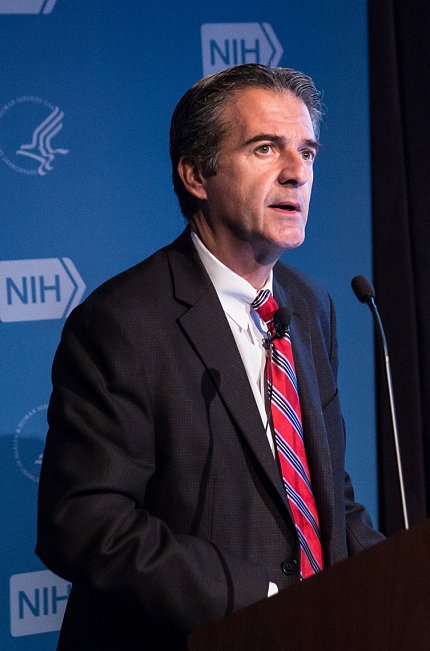Excess Growth Hormone Increases Risk of Heart Disease, Diabetes

Photo: Chia-Chi Charlie Chang
Diseases of excess growth hormone, such as gigantism and acromegaly, may initially present with a variety of signs and symptoms, including diabetes, said Dr. Andrew Demidowich during a recent Grand Rounds lecture in Lipsett Amphitheater.
“The terms gigantism and acromegaly get thrown around together, but they’re not equivalent; they’re a little different,” explained Demidowich, an assistant research clinician in the Office of the Clinical Director at NICHD. He went on to clarify that gigantism results when excess growth hormone is produced before the growth plates of long bones (e.g., arms and legs) close. Consequently, people with gigantism are very tall.
In acromegaly, conversely, the growth excess begins after puberty, when the growth plates have already closed. As a result, those with acromegaly may have large skulls, jaws, nose, ears, palms and feet, but not the extremely tall height seen in gigantism.
Demidowich said the pituitary gland produces growth hormone after it receives a signal from the hypothalamus. Normally, the hormone stimulates bone and muscle growth, cell reproduction and regeneration. The hormone “isn’t secreted constantly, but rather comes in pulses or bursts,” especially when we sleep.
In one case, an otherwise healthy teenager visited a local hospital complaining of nausea and vomiting. Doctors ran a battery of tests and diagnosed him with diabetic ketoacidosis, a life-threatening condition that develops when a person’s body doesn’t produce enough insulin. Doctors treated him with insulin, but a day later the ketoacidosis returned.
The patient was 6’9’’ and had to change his shoes every 3 months because he had grown so fast. He had frequent headaches, had a deep voice and developed skin tags around his neck. Upon reexamination, the doctors realized that his diabetes was probably the result of a different disease: gigantism. He was referred to the CC for further work-up.

Photo: Chia-Chi Charlie Chang
Usually, the cause of excess growth hormone is a benign, noncancerous tumor called a pituitary adenoma, Demidowich said. Excess growth hormone spurs the liver to produce high levels of insulin-like growth factor 1, or IGF-1. Elevated levels of IGF-1 cause many of the symptoms of acromegaly, including increased risk of heart failure and diabetes.
Although the connection between diabetes and growth hormone excess isn’t well recognized by clinicians or endocrinologists, Demidowich said, the condition “is seen in about 25 percent of individuals with acromegaly.” When there’s too much IGF-1, it hampers the body’s ability to deal with glucose. Patients may be given insulin to control the diabetes.
Typically, gigantism and acromegaly are treated by removing the adenoma, followed by drug therapy. If remnants of the tumor survive surgery and medication, doctors may recommend radiotherapy.
The surgery is complicated because cranial nerves and carotid arteries surround the pituitary gland, which is “nestled at the base of the brain,” said Dr. Prashant Chittiboina, assistant clinical investigator in the neurosurgery unit for pituitary and inheritable diseases at NINDS. Surgeons approach the tumor through the nasal cavity.

Photo: Chia-Chi Charlie Chang
When the tumor is large, “it’s not uncommon to see that the surgeon is unable to remove all the tumor tissue. Post operatively, individuals are put on medications to ensure long-term remission,” Demidowich said.
In the case of the patient treated at the CC, surgeons were able to remove most of the tumor. After the procedure, the patient was given medication, which brought down IGF-1 and his insulin requirements. The medication had significant side effects, so he opted for radiotherapy to destroy any remnants of the tumor. Most likely, he won’t have to take the acromegaly medication for the rest of his life.
“We’re treating a patient, not just a disease,” Demidowich said. “Our patient, understandably, had difficulty coping with a significant diagnosis and impact on his life, and he was just a kid—still in high school.”
Dr. Constantine Stratakis, director of the Division of Intramural Research and head of the section on genetics and endocrinology at NICHD, said that gigantism and acromegaly are frequently the result of genetic defects that may be inherited or occur within the tumors that cause the disease. Indeed, there are several genetic mutations that are present in patients with growth hormone excess that Stratakis and his laboratory have studied.
The teenager with gigantism did not have any of these mutations; it is likely that his disease was caused by a defect that has not yet been discovered.
“There are a lot of genes to find in acromegaly and our lab is actively working to find them,” Stratakis concluded.
